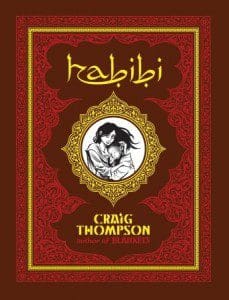 There are some artists and writers that truly utilize the medium of comic books and graphic novels to create a unique narrative experience that only sequential art can deliver. Craig Thompson is one of those individuals.
There are some artists and writers that truly utilize the medium of comic books and graphic novels to create a unique narrative experience that only sequential art can deliver. Craig Thompson is one of those individuals.
Following the success of his semi-autobiographical Blankets, Thompson has once again given readers a poignant and sincere tale of love and spirituality in Habibi (Pantheon; 672 pages). Set in a world that is both historical and modern, mixing epic deserts and extravagant palaces with modern city landscapes and industrial wastelands, readers follow Dodola and Zam, two children who escape from slavery by fleeing to the desert. They struggle against a world of greed, lust, and refuse, which forces their paths apart. It is their evolving spirituality, their love for each other and for storytelling that moves them to find each other again.
Habibi contains a cast of characters that are sympathetic and cartoonish. Dodola, Zam and a number of supporting characters are achingly human, while the simpler characters in the story are there to either propel the plot forward or to reinforce the narrative’s symbolic qualities.
Thompson’s writing makes great use of Islam, sharing many of its teachings, tales, and lessons concurrently with Dodola and Zam’s story, providing a lens to view their circumstances and to inform past and future events in the story. Thompson also uses Islam as a guide for navigating Habibi’s many themes, such as romantic and familial relationships, our ties to nature, and the consequences of wastefulness. And as if trying to combat post-9/11 antagonism toward Islam, Habibi showcases the faith’s beauty.
For a graphic novel, the art is just as important, of course, as the writing. Throughout, Thompson’s ink work is nothing short of awe-inspiring, especially in the book’s many breathtaking double-page spreads. The amount of detail is unbelievable; one can see why it took Thompson eight years to follow-up Blankets. And the compositions within each panel are moving and full of life, as if each panel can tell a story of its own. He also does an admirable job of controlling the pacing of the reader’s eye — and, as a result, the pace of the story — through placement of the words and the layout of the panels. Page layouts easily draw the eye to where Thompson wants it to go, and in many cases creates beautiful eye lines across pages, creating an almost musical rhythm to his storytelling.
Habibi is a prime example of what could never be done with words or art alone, and why sequential art exists. It is an ambitious landmark work in the history of the graphic novel.
